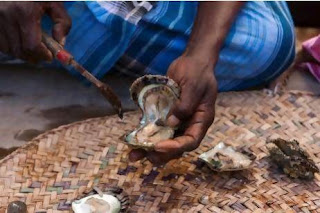Fishing of Pearl Oyster in India
Fishing of pearl oyster in order to obtain pearl is known to Indians since ancient days. The chief sources of pearls are marine pearl oysters, however the fresh-water molluses are also known to produce pearls but they are of poor quality and almost worthless.
Pearl oysters are generally found attached to the rocks or dead coral reefs. When present in large number at a particular place they form, pearl banks or pearl beds. The optimum depth for the occurrence of pearl oyster is 22-25 metres, usually 15—20 Kilometres away from the shore.
In India pearl oysters are collected by divers. Divers with the help of sinking stones go deep into water and collect the oysters in small bags tied around their waist. The amount of collection depends on the skill of the diver and his capacity to hold breath under water.
The time of collection is in the morning till mid-day. The best season for pearl fishing is summer during which the sea remains calm and clear. The days collection are brought to the beach and are left there for few days during which they get partially decomposed. Shells of the decomposing oysters are then removed by hand so that the inner contents get exposed for various types of infections and parasitic attack.
In next 3 to 4 days the mass becomes too soft and are then rinsed with several changes of water. The heavier part or debris which may bear pearl settle down in the container in the container which washing has been done. The sediment is rinsed and washed several times so that the pearls get released from the mass. Finally the pearls are picked up by hand.
Pearlculture:
Although pearl and its uses are known to human beings since ancient times, it was Japan which has the honour of developing techniques to culture pearl oyster and obtaining pearl out of them by introducing artificial devices. The pearls obtained by this method are of fine quality and are similar to that of natural one. The culture of pearl has come to such a success that has almost captured the whole of world market.
Japanese are a little conservative in disclosing the detail technique of the cultural procedure because it is their trade secret. Japan is the chief producer of pearl and dominates the world market. Pearl culture on commercial line has not been done in India.
It was Mr. Mikimoto, Japanese, who for the first time discovered the art of cultivating the pearl oysters. The first pearl produced in 1894 by artificially employed techniques were not up to the standard. But due to constant and endeavouring labour he could achieve his goal in 1913 and produced pearl by cultures which were just like that of natural ones. Since then pearl industry is flourishing in Japan.
The basic principle of Pearl-Culture is to introduce some foreign materials between mantle and shell of the oyster, which out of irritation will produce nacrous layers around that foreign body which in time will become pearl. The outline of the process has two main aspects (i) Formation of oyster bed (ii) Surgical impregnation of foreign particles in the oyster.
The first step needs certain areas of shallow waters to be formed as oyster bed or oyster farm. The important oyster beds in Japan are situated in Ago Bay, Katla Bay, Matoza Bay, Heijo Bay, Mikimoto Bay, Omura Bay, and Nanao Bay etc. Stones, layer’s of woods, dead corals etc. are laid in these shallow coastal sea areas on which the oysters deposit their “spat”. New methods for the collection of larvae have been evolved in which metallic cages are let down in the sea which collect the floating larvae from off shores.
The collecting spat are transferred to the site of culture where these oysters under constant watch are grown to a considerable size. Only after they attain a moderate size, they undergo the surgical impregnation of foreign bodies. The laboratories for this purpose are established just by the side of the cultural ground so that the treated oysters may be quickly placed back to the water.
For impregnating the foreign body, a tiny bag made from the mantle parenchyma of fresh water mussel is formed in which are placed fragments of tissue or some round particle. The mouth of the bag is then closed temporarily by cotton thread. By giving a slight incision, the bag is placed into the subcutaneous tissues of the mantle. The cotton thread is withdrawn and after the application of some antiseptic, the oyster is returned to the water. The surgical process is not only very delicate but it also require quickness because oyster should not be kept out-side their normal environment for a long time. For this purpose the technicians are specially trained. Pearl oysters grow 90—105 m.m. across in about four to five years, after which they are ready for harvesting.
by Saritha Pujari
Source: www.yourarticlelibrary.com
